NASA’s Advanced Composite Solar Sail System Launched Into Space, To Redefine Propulsion
On April 23, the Advanced Composite Solar Sail System CubeSat mission launched successfully aboard an Electron rocket launched by Rocket Lab and carried NASA’s experimental solar sail technology into space. This launch marks a significant milestone in the development of solar sail technology, which could revolutionize space exploration.
What is Solar Sail Technology?
Solar sail technology is a form of spacecraft propulsion that uses the power of sunlight to propel itself through space. Solar sails are large, reflective sheets that are deployed from a spacecraft and are pushed by the sun’s radiation. This radiation exerts a small amount of force on the sail, which is enough to accelerate the spacecraft over time.
Solar sail technology has several advantages over traditional rocket propulsion systems. First, solar sails do not require any fuel, which means that they can theoretically operate indefinitely. Second, solar sails can achieve very high speeds, making them ideal for long-distance travel. Third, solar sails are very lightweight, which makes them easy to launch into space.
How Does Solar Sail Technology Work?
Solar sail technology is based on the principle of momentum transfer. When light strikes a solar sail, it is absorbed or reflected. When the light is absorbed, it transfers some of its momentum to the sail. This momentum transfer causes the sail to move in the opposite direction of the light.
The amount of momentum that is transferred to the sail depends on the wavelength of the light. Shorter wavelengths of light, such as ultraviolet light, have more energy than longer wavelengths of light, such as infrared light. This means that shorter wavelengths of light transfer more momentum to the sail than longer wavelengths of light.
The orientation of the solar sail can be adjusted to change the direction of the force that is applied to the sail. By adjusting the orientation of the sail, the spacecraft can control its direction of travel.
Benefits of Solar Sail Technology
- No fuel required: Solar sails do not require any fuel, which means that they can theoretically operate indefinitely. This makes them ideal for long-distance travel and for missions that require extended durations.
- High speeds: Solar sails can achieve very high speeds, making them ideal for long-distance travel. Solar sails have the potential to reach speeds of up to 20 kilometers per second (12 miles per second).
- Lightweight: Solar sails are very lightweight, which makes them easy to launch into space. This makes them ideal for small spacecraft and for missions that require a low-cost launch vehicle.
- Low cost: Solar sails are relatively inexpensive to manufacture and operate. This makes them a cost-effective option for space exploration.
Challenges of Solar Sail Technology
- Low thrust: Solar sails produce a very small amount of thrust, which means that they can only be used for long-distance travel. Solar sails are not suitable for missions that require rapid acceleration or deceleration.
- Fragility: Solar sails are very fragile and can be easily damaged by space debris. This means that they must be carefully protected during launch and operation.
- Deployment: Solar sails are large and difficult to deploy in space. This can make them difficult to use for missions that require a quick deployment.
Future of Solar Sail Technology
Solar sail technology is still in its early stages of development, but it has the potential to revolutionize space exploration. Solar sails could make it possible to travel to distant destinations in the solar system and beyond. They could also be used to create solar-powered satellites that could provide power to Earth and other planets.
The launch of NASA’s Advanced Composite Solar Sail System is a major milestone in the development of solar sail technology. This launch will help to demonstrate the feasibility of solar sail technology and will pave the way for future missions that use this technology.

